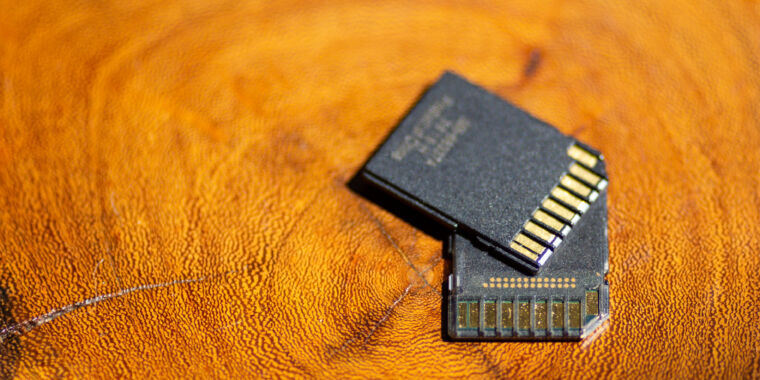- cross-posted to:
- technology@lemmy.zip

I can’t fathom a good reason for 4TB SD cards.
Most cameras have CF Express which is probably 5-8 times faster.
Even UHS-III is 600MB/s while CF Express Type B is hitting 4GB/s.
Even so, why would you risk 4TB of data on removable storage.
CF Express is also running PCI-E. This article isn’t talking about SD Express.

I think it’s primarily targeting the handheld gaming market

My laptop has an SD card slot. So if this were reliable I could add a significant permanent storage capacity to my laptop.

Valid point, but I think most built in SD card slots are on a laptop can read 100MB/s. Hopefully yours is perhaps USB 3.0 speeds.

It’s good for offloading things that otherwise eat useful fast storage.
For example, OneNote uses a cache and a backup folder. So whatever size your notebook is, it will consume 3x that storage space.
I use the SD slot for the cache and backup folders (my backup folder is synced to a file server, so I don’t need it locally, and in 15 years of using OneNote, I’ve needed that backup one time).
It’s also useful for temporary stuff that you don’t care about/is available elsewhere. I’ll pull large installers from my file server and put them on the SD, until l I get around to using them (laptop drive is 250, which is tight for me, and the SD was a quick, dirty solution since I have a bunch of micro SD’s from phones over the years).

If you set it up properly (like using apps to sync folders) a big enough sd is like local “cloud” service.
I was thinking about it recently, after my phone data were very close to being deleted (I managed to prevent it eventually), I was angry at how not having an sd slot caused me so many issues. If I had a 1tb sd I would just autosync app backups and files to my card and not worry ~at all about losing data from bootloops etc.

3-2-1

I would happily use one for my music and movies to access them on the go. I already have copies elsewhere, so it would be no big loss if the card died.

Meanwhile I’m struggling to find 4MB SD cards, so I can easily overwrite it with random data to securely wipe it between uses.
How the heck do people with 4TB SD cards do data hygiene wipes of their medium before crossing international borders? That would take days…

How the heck do people with 4TB SD cards do data hygiene wipes of their medium before crossing international borders?
They don’t

I don’t know what your particular situation is but if you’re just using it on computers you could use LUKS or BitLocker or FileVault. Then if you want to wipe it, you only need to destroy the key and the data is rendered effectively gone.

Yeah that’s best for most things, but SD cards are generally used in situations where that’s not an option. Namely for use in (video) cameras.
The other situation is when I need to transfer a large file to someone else’s device where encryption isn’t an option (rare but happens)

I assume you’re joking, but if not: the 4MB of flash you see is not mapped 1:1 with 4MB of actual flash on the SD card. Instead there might be something like 5MB, but your OS only sees 4MB of that.
The extra unallocated space is used as spare sectors (sectors degrade and must be swapped out) or even just randomly if it somehow increases IO performance (depending on the firmware).
Erasing the 4MB visible to your OS will not erase everything, there still may be whole files or fragments of your files sitting in the extra space. Drive-vendor specific commands can reliably access this space (if they exist and are available to you, which they mostly are not). Some secure erase commands may wipe the unallocated space but that’s vendor specific, not documented and I don’t think even supported over the SD interface (although I might be wrong on this last point).
Encryption and physical destruction are your best bets.

Link to source? The file size discrepancy is usually due to 1000 vs 1024, but filling the drive with random data until its full should wipe the drive.

A good search term is “SSD over-provisioning”
The file size discrepancy is usually due to 1000 vs 1024
No, that’s something else entirely. It doesn’t matter what measurement system you use, the drive juggles more sectors than your OS can see.
but filling the drive with random data until its full should wipe the drive.
Only if you assume people can’t access the reserved/unallocated/over-provisioned sectors. If you are only worried about small thieves then this might not be an issue. If you’re handling sensitive data (like medical records for other people or anything with sensitive passwords) then it’s completely inadequate to leave any form of data anywhere on the disk.

If only I could get this much storage on my Mac.

and i still cant use it in most phones cause there is no freaking port!

To be honest, SD cards are usually not meant for extending storage anyway. They should only ever be used for temporary storage like taking pictures and later transferring them to some other storage medium.

In addition, manufacturers will make a smaller and easier to lose format.

That’s just Micro SD cards.

Yeah but when can I get a 4TB floppy?

when 4TB is stressed.

Do people setup RAIDs with sd cards? There should be a super mini box for a sd card RAID

I doubt they would be reliable enough for a RAID array. It would be much better to use m.2 drives.

They’re not reliable individually, but they’d be perfectly reliable in RAID if replaced promptly.
Although since SD cards degrade on read, I would want to have at least RAID 6. Reading all the data for a rebuild could result in another one dying.

You probably don’t want it
https://www.youtube.com/watch?v=O2jKKFUnycA
https://www.youtube.com/watch?v=3frnBoqqI_Q
I tried to watch it but that guy is just way too boring to listen to

I know right? It’s like he and Linus(LTT) are at opposite ends of the spectrum. Long story short, it’s not worth it.

More writes, more failures. SD cards work best when you write once and don’t delete it for a long time

Sure. Look on aliexpress for “SD Raid” and you will find some for ~$15

SD is a poor choice (though could be an interesting solution in certain cases, maybe).
SSD and M2 can be used, if you get the right SSD, and ensure everything is setup properly.
Even SSD doesn’t guarantee a lower power consumption than 2.5" spinning disk drives - it depends on the drives and usage patterns (mostly the drives).
The self-hosting community discusses this quite a bit.

Come on guys, I’ve had an 8TB microsd card since 2018…my files just start to act funny whenever it is fuller than 8GB ;)

Finally! Been waiting for this for since Pacman wouldn’t fit on my punch card. 2025 here we come!

Switch is old now.

Aren’t SD cards slow and prone to failures?

The ones used for 4K recordings are not slow 100+MBps, I won’t say prone to failure as such, flash storage can only handle a finite number of writes but we can mitigate that by using wear leveling.

That’s pretty slow for terabyte sized storage. And slow compared to the alternatives, too (600 MB/s or Gabs/s).
Spinning hard disks are faster than this, too. Have been for decade(s).

I wish SD Cards also had some specifications for random access speed.
I used to have a UHS-I SanDisk card which felt much faster than my current UHS-III Samsung card. It’s really evident when searching through the storage, waiting for photo thumbnails to cache, etc…
I am not sure whether to go for a UHS-I SanDisk or UHS-III Samsung next. That SanDisk might not handle higher bitrate 4K.

Hehe, I think I haven’t caught up with the improvements, flash with 1GB/s transfer speed is ludicrously fast!

All SSD and NVMe are also “just flash”, and reach 5GB/s and more, often limited by the available interface bandwidth until very recently.

Other formats can exceed that by caching & writing to multiple chips at once i guess.

Tempting, but I’m waiting to see whether SD cards catch on before buying in.

Who need that much storage on their phone? Honestly asking.

This isn’t about phones. It’s mainly about cameras recording 4k/8k video, and devices such as the steamdeck storing lots of games.

That make sense. Thanks.

Yeah, I’ve filled 256GB pretty easily by recording on an action camera all day, maybe for a couple of days. 4TB would be very convenient for a holiday.

Unfortunately, the card mentioned in the article is far too slow to record high resolution, high bit-rate video from even older “pro” cameras.

Storage needs kind of grow to the size of their container. Like a goldfish.

Really depends on the person. I have never managed to fill up a 128 gigabyte phone, but that is because I am blind, so I am not taking pictures in 4K videos. The biggest thing on my phone is my music collection, which only takes about 5 gigs or so. This phone that I have now is a 64 gigabyte phone and while it’s mostly full, it’s still not there yet. According to the Android settings, I still have about 23 gigabytes left on this 64 gig phone. It says I have used about 64% and if this were a 128 gig phone, that would be about 32% or so.

Me. I am basically trying to squeeze the desktop (PC) out of my phone, so there’s a lot of “unnecessary” stuff.
For example, I am currently deciding whether to keep the 110GB of DVD ISO files which I can stream from my phone using VLC (on client side) which are served by nginx server from my phone (this way I still get all menus, just like with a physical DVD) or delete it and replace it with equally sized 110GB EN Wikipedia maxi .zim package, install kiwix-tools on Termux and set up nginx on Termux to serve as revese proxy to kiwix-serve so I could also host a mirror of the whole English Wikipedia, including (downscaled) images on my phone. I guess that sounds cooler than DVDs.
Or I should get a 512GB SD card and keep both.
I can’t afford 1TB one.But yeah, that’s just one example. My 256GB SD card is about to pop while my video and music collection (The latter of which which is also served using Navidrome server in Termux 🙂. For videos I just use nginx with material fancyindex theme.) keeps growing.
I already have to keep some stuff on phone’s internal storage.Termux is godsent. Otherwise I’d absolutely have to get a PinePhone as I couldn’t live with something as locked down as Android or even iOS without a nice terminal emulator.
Alternatively, I could benefit from pocket-sized passively cooled laptop.
Thanks. That sounds pretty cool.

I have 128gb SD on my phone and it’s alway full.
Partly a mismanagement issue, but my music library at home is more than 120gb. I’d rather just carry my full library - why not? Storage is cheap.
Then there’s video. I prefer pulling video on wifi, rather than stream and burn data. Again, why not? Storage is WAY cheaper than cell data. And I’m being a good neighbor by leaving bandwidth available for other uses.

Phones don’t have (full size) SD card slots, this is for cameras and such.

I won’t mind that much storage, the 256GB I have are nearly full.

I’m using a 128GB phone and it’s never full. But I export photos And videos off it once every 6 months. If I didn’t I’d need 1TB phone.

Once every 6 months?
So at any one time you could lose 6 months of photos?
Or do you have a regular sync to somewhere, and this is just space freeing?

I’m not deleting them. They’re uploaded to the cloud at the time of creation. I also move them off my phone to my computer every 6 months or so - I do this just in case the upload to the cloud has ever silently failed. I deduplicate the images, so I don’t have multiple versions of the same image with different file names.
For me it’s not entirely about space. I rarely let the device get more than 2/3rds full. It’s also about speed. If I want to pull a photo/video off my phone, it seems sluggish when there are thousandths of files in that one directory.

Ah, yea, I see. Makes sense. Minimizes your risk while also minimizing your effort to manage them.
Yea, I don’t mind having photos on my phone, but managing them is far easier on a pc. So like you, mine all sync to my PC instantly, then when I feel like it I spend some time there cleaning them up (and the changes sync back).
Since the PC has Crashplan for backup, and a NAS it syncs too, I feel pretty comfortable my stuff is safe.

Same. I should have gotten a 512GB Micro SD. “I could never use that much storage.” Yeah, I could.

What do you use all that storage for?

Apps, photos, audio books, and the OS.

and the OS
PinePhone?

Nope just plain old Android, haven’t gotten around to using something better
This is the best summary I could come up with:
Western Digital will launch the SD card, which follows the SD Association’s Secure Digital Ultra Capacity (SDUC) standard, under its SanDisk brand and market it toward “complex media and entertainment workflows,” such as high-resolution video with high framerates, using cameras and laptops, the announcement said.
The spacious card will use the Ultra High Speed-1 (UHS-1) bus interface, supporting max theoretical transfer rates of up to 104 MB per second.
“Attendees will get a preview of the 4TB SD card’s full capacity and learn more about how it will expand the creative possibilities for cameras and laptops,” Western Digital said.
Western Digital didn’t say what the SD card would cost, but with its advanced capabilities and targeted audience of professional creators, the offering will likely have premium pricing.
However, Western Digital’s announcement also comes as SanDisk’s reputation for reliable storage is in serious question by professional and long-time customers.
These alleged failures, combined with frustration around Western Digital’s limited response to reported data losses, could have professionals with work-critical storage needs consider waiting for another brand to make the leap to 4TB.
The original article contains 566 words, the summary contains 180 words. Saved 68%. I’m a bot and I’m open source!

